|


I was really prepared
to hate The Dunwich Horror. I remember I had hated it the first
time I saw it. I hated it the second time I saw it. I put off seeing
it a third time 'till now... and I even put it off again by subjecting
myself to The Astro-Zombies last week. But
my pal Dave wanted his tape back, and that copy of Jack Frost
I wanted to rent was gone, so I eased myself into The Dunwich Horror
a half-hour at a time. And you know what? It doesn't suck. Much.
You see, "The Dunwich
Horror" was only the second H.P.
Lovecraft story I had ever read (the first was "The Colour Out of Space"),
and it creeped me out like few pieces of prose had before or since.
As such, it still holds a special place in my heart. Briefly: Dunwich
is one of those little, determinedly rural New England towns that Stephen
King is so fond of, and it's haunted by a nearby hill called the Devil's
Hopyard, and a family of sorcerers called the Whatelys. Wilbur Whately,
the last of the breed, visits Miskatonic University to attempt to acquire
the Necronomicon, a fabulously rare book about the Old Ones,
a prehistoric race of god-like beings banished from Earth, but still
attempting to return. After he is denied his request, Wilbur returns
to steal the book, and is mortally savaged by guard dogs, revealing
that, under his bulky clothing, Wilbur was not human at all.
What no one suspects is that Wilbur has a twin brother, locked up at
the old Whately place, and with no one to feed him, he gets hungry,
busts out, and proceeds to chow down on the local populace. As the hero,
Dr. Armitage reveals in the denouement: "It was his twin
brother, but it looked more like the father than he did." first was "The Colour Out of Space"),
and it creeped me out like few pieces of prose had before or since.
As such, it still holds a special place in my heart. Briefly: Dunwich
is one of those little, determinedly rural New England towns that Stephen
King is so fond of, and it's haunted by a nearby hill called the Devil's
Hopyard, and a family of sorcerers called the Whatelys. Wilbur Whately,
the last of the breed, visits Miskatonic University to attempt to acquire
the Necronomicon, a fabulously rare book about the Old Ones,
a prehistoric race of god-like beings banished from Earth, but still
attempting to return. After he is denied his request, Wilbur returns
to steal the book, and is mortally savaged by guard dogs, revealing
that, under his bulky clothing, Wilbur was not human at all.
What no one suspects is that Wilbur has a twin brother, locked up at
the old Whately place, and with no one to feed him, he gets hungry,
busts out, and proceeds to chow down on the local populace. As the hero,
Dr. Armitage reveals in the denouement: "It was his twin
brother, but it looked more like the father than he did."
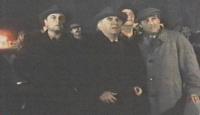 The radio
series Suspense did an adaptation of "The Dunwich Horror"
back in the 40's, with Ronald Coleman as Armitage. It was a fair adaptation,
and they were quite brave to have attempted it at all *
- but the point is, Suspense was a half-hour show, and they didn't
leave much out, save Lovecraft's trademark purple prose - so..... how
do you stretch it out to movie length, and do it with a Corman budget? The radio
series Suspense did an adaptation of "The Dunwich Horror"
back in the 40's, with Ronald Coleman as Armitage. It was a fair adaptation,
and they were quite brave to have attempted it at all *
- but the point is, Suspense was a half-hour show, and they didn't
leave much out, save Lovecraft's trademark purple prose - so..... how
do you stretch it out to movie length, and do it with a Corman budget?
Oh, yes, Roger Corman
is the Executive Producer, this time around, so it's no surprise that
this 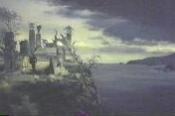 adaptation uses his Poe
films as a sort of model: We know the original story is in there, because
we see little glints and glimmers of it, like flotsam sticking out of
the sand at low tide. The original story occupies only the final 10-20
minutes of the flick. The bulk of the movie is taken up by a framing
device, a variation on, or extrapolation of, the original story. that
serves to get us to the pit with the pendulum, or the masquerade ball,
or... the Devil's Hopyard. adaptation uses his Poe
films as a sort of model: We know the original story is in there, because
we see little glints and glimmers of it, like flotsam sticking out of
the sand at low tide. The original story occupies only the final 10-20
minutes of the flick. The bulk of the movie is taken up by a framing
device, a variation on, or extrapolation of, the original story. that
serves to get us to the pit with the pendulum, or the masquerade ball,
or... the Devil's Hopyard.
Usually, the framing
device concerns the arrival of an outsider of one kind or another,
as in Fall of the House of Usher, Pit and the Pendulum, and
even director Daniel Haller's first Lovecraft 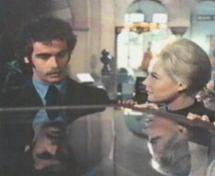 film
for AIP, Die, Monster, Die! (based on the aforementioned "Colour
Out of Space"). This time, however, the new scenario concerns
a much more human Wilbur (Dean Stockwell), still trying to get the
Necronomicon, but also spending a goodly portion of the picture seducing
Miskatonic student Nancy (Sandra Dee) via love philtres and good old
satanic film
for AIP, Die, Monster, Die! (based on the aforementioned "Colour
Out of Space"). This time, however, the new scenario concerns
a much more human Wilbur (Dean Stockwell), still trying to get the
Necronomicon, but also spending a goodly portion of the picture seducing
Miskatonic student Nancy (Sandra Dee) via love philtres and good old
satanic 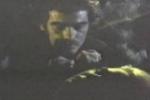 know-how. Seems Wilbur wants
to re-create the ritual that resulted in his birth, and this time
do it right. Once again, it's up to Armitage and his knowledge
of the Necronomicon to save the day. know-how. Seems Wilbur wants
to re-create the ritual that resulted in his birth, and this time
do it right. Once again, it's up to Armitage and his knowledge
of the Necronomicon to save the day.
Beyond that central conceit
- the substituting of sex for Cosmic Horror - the story remains a reasonable
facsimile of the source material. It is exactly that conceit, however,
that I think turns off most Lovecraft fans. I get the impression Lovecraft
very much wished to be a contemporary of Dickens; he would have been
horrified by the naked breasts in the dream scenes (as it is a Corman
movie, there must be a dream scene, and the Old Dark House must
burst into flames) of this M-rated version of his tale.
To be sure, there's not
much to recommend this movie - through most of it, you will be left
with an uncanny feeling that you're watching an overly-long episode
of Night Gallery. But there were some 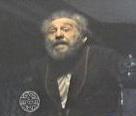 interesting choices
made: the magic symbols seem based on Meso-American carvings, especially
in the case of the Thunderbird on the staff that Old Whately (Sam Jaffe)
carries; the ritual magic is consistent and appears quite convincing.
The ocean is used throughout as shorthand for timelessness and eternity,
and the Twin's presence is made known by a combination of the over-used
heartbeat and the sound of water slushing interesting choices
made: the magic symbols seem based on Meso-American carvings, especially
in the case of the Thunderbird on the staff that Old Whately (Sam Jaffe)
carries; the ritual magic is consistent and appears quite convincing.
The ocean is used throughout as shorthand for timelessness and eternity,
and the Twin's presence is made known by a combination of the over-used
heartbeat and the sound of water slushing 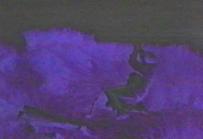 about.
Later, as the Twin rampages about the countryside, what appears to be
the backwash from a helicopter or a cleverly-placed wind machine rustles
trees and disturbs the surface of ponds as the creature passes. In the
original, the beastie was invisible; here, apparently people can see
it, and, as it is 1969, the beastie also causes flashes of psychedelic
color... possibly the best they do on the budget. about.
Later, as the Twin rampages about the countryside, what appears to be
the backwash from a helicopter or a cleverly-placed wind machine rustles
trees and disturbs the surface of ponds as the creature passes. In the
original, the beastie was invisible; here, apparently people can see
it, and, as it is 1969, the beastie also causes flashes of psychedelic
color... possibly the best they do on the budget.
The use of wind and light
is effective enough that one wishes there were more. A large part of
the failure of Horror is that most of the first hour is taken
up by the seduction and a few side-trips, such as Wilbur trying to bury
Old Whately in the Dunwich graveyard, replete with Necronomicon-esque
burial service, raising the ire of the locals. Why is that scene
even there? Except to establish (although already established time and
again) that the Dunwichites are not particularly sympathetic? This leaves
the Beastie at Large only fifteen minutes or so to play out, leaving
no time for building suspense or a 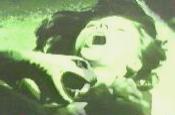 sense of
fear. Person strays from crowd, person gets eaten, another person strays
from crowd. That Haller passed up this opportunity to make use of some
of the dread that oozes from Lovecraft's story is suspect at worst,
lamentable at best. resulting in one of the lamest climaxes in film
history, as Wilbur and Armitage shout opposing curses in weird languages
at each other, until Wilbur gets struck by lightning. The end. sense of
fear. Person strays from crowd, person gets eaten, another person strays
from crowd. That Haller passed up this opportunity to make use of some
of the dread that oozes from Lovecraft's story is suspect at worst,
lamentable at best. resulting in one of the lamest climaxes in film
history, as Wilbur and Armitage shout opposing curses in weird languages
at each other, until Wilbur gets struck by lightning. The end.
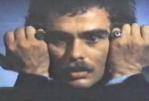 It's hard to take Dean Stockwell
seriously as a Demonic Seducer, yet he does have his moments (I can't
say that the original choice for this role, Peter Fonda, would've It's hard to take Dean Stockwell
seriously as a Demonic Seducer, yet he does have his moments (I can't
say that the original choice for this role, Peter Fonda, would've been any
better). Sandra Dee is called upon to do nothing more but exude a sort
of somnambulistic sultriness. Ed Begley, in his last role as Dr. Armitage,
seems a bit lost amongst all this mumbo- jumbo, but he gamely works
his way through the film with dignity intact. If you look closely, you'll
notice that the nurse - been any
better). Sandra Dee is called upon to do nothing more but exude a sort
of somnambulistic sultriness. Ed Begley, in his last role as Dr. Armitage,
seems a bit lost amongst all this mumbo- jumbo, but he gamely works
his way through the film with dignity intact. If you look closely, you'll
notice that the nurse -   who
drives down the who
drives down the
wrong stretch of road at the wrong time and finds herself on the psychedelic
supper dish - is none other than Talia Coppola, who would later become
Talia Shire.
I'm sure a lot of my
earlier hatred of this title was based on TV viewings - I was 12 years
old when it came out, too young for the 'M' rating (ah, back when the
ratings system was sane....) - and, as I recall, CBS ran it first, as
an edited, muddled mess, even cutting out the final fade on a fetus
growing within Nancy, letting us know that Wilbur was not entirely unsuccessful.
They even cut out Wilbur's as-much-accident-as-anything murder of a
library guard, rendering Armitage's grim remark, "You saw what
he did to get that book!" a bit....reactionary?
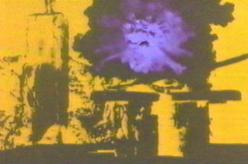 In short - not as bad as it could
have been. Sadly, not as good as it could have been, either.
It would have benefitted from a stronger script - say, from the Poe
films' Richard Matheson or Charles Beaumont. Or, better yet, the writers
that were involved could have trusted the source material more. In short - not as bad as it could
have been. Sadly, not as good as it could have been, either.
It would have benefitted from a stronger script - say, from the Poe
films' Richard Matheson or Charles Beaumont. Or, better yet, the writers
that were involved could have trusted the source material more.
|